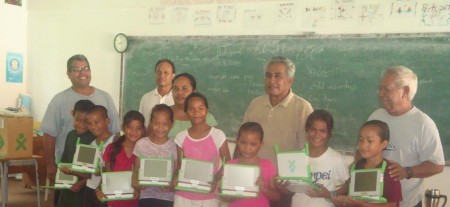Since our first partnership with the Secretariat of the Pacific Community, which began in 2008, OLPC has seen significant deployments in Niue (the first country in the world to realize one laptop for every child), Nauru, the Solomon Islands, Vanuatu, and Papua New Guinea.
Last year we expanded our work in the region to start pilots in 12 other countries from the Pacific Island Forum.  One of the pilot projects developed was a well-received program in Kosrae, one of the four states of Micronesia.
As Michael Hutak reports on the OLPC Oceania blog, we are now working with Micronesia to build on the success of that pilot. Kosrae recently secured a $400K Supplemental Education Grant from the United States under the Compact of Free Association agreement between the US and Micronesia. Kosrae plans to implement a full-scale deployment of OLPC to all of their students from 1st to 8th grades.

In July, Kosrae deployed laptops to all 810 students and teachers in grades 5-8. Â The first laptop was handed out at Utwe Elementary School, by Kosrae State Governor Lyndon Jackson (with Department of Education Director Lyndon Cornelius looking on).
A ceremony was held at Tafunsak Elementary School to announce the program, attended by US Ambassador Prahar, who encouraged everyone involved to use their new tools well.  As Oceania expands its OLPC program, this looks like a model to follow, with collaboration from many sectors of the local and international community.

A photo from the handout at Wachung Elementary school, visited by Cornelius and former Senator John Martin.
The second half of the deployment, for the students and teachers in grades 1-4, will take place later this year.
